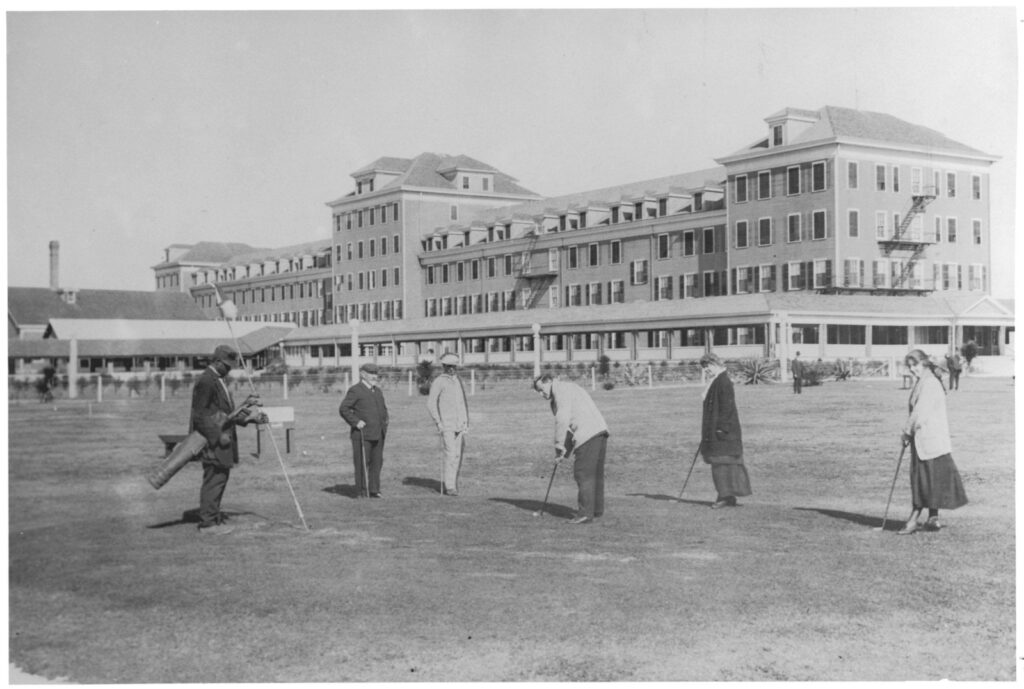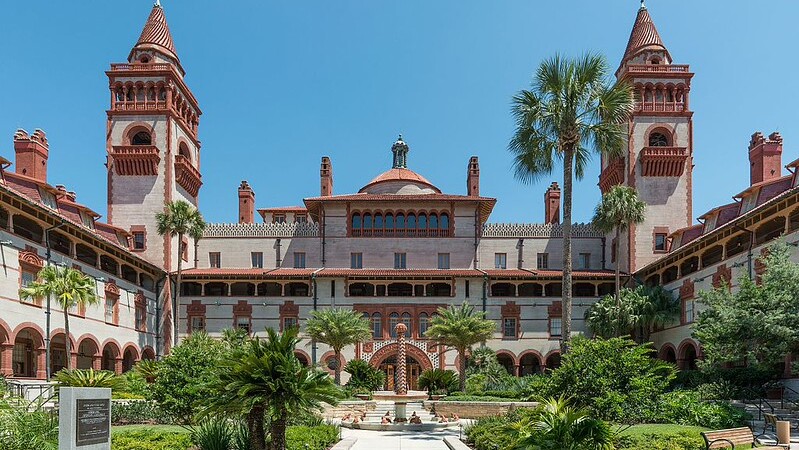
Considered to be the brains behind John D. Rockefeller’s Standard Oil Co., Henry Morrison Flagler is recognized as one of the most influential individuals in the development of Florida. Following his success as a founding partner of Standard Oil, Flagler built the Jacksonville Terminal and the Florida East Coast Railway between Jacksonville and Key West, leading to the growth of cities such as Miami, Fort Lauderdale and West Palm Beach. In addition, he was known for his chain of Gilded Era luxury resort hotels, some of which still remain today. Here are the Gilded Era hotels of Henry Flagler.
Hotel Ponce de Leon
St. Augustine, Florida

When Henry Flagler opened the Hotel Ponce de Leon on Jan. 10, 1888, it was the first of its kind constructed entirely of poured concrete, using local coquina stone as aggregate. Also known as The Ponce, the hotel was one of the first buildings in the country wired for electricity, courtesy of Flagler’s friend Thomas Edison. The Spanish Renaissance Revival style structure was the first major commission for Carrère & Hasting, the New York-based architecture firm that later designed the famed New York Public Library.
Over the years, noted guests included Babe Ruth, Somerset Maugham, Mark Twain and Presidents Grover Cleveland, Franklin D. Roosevelt, Theodore Roosevelt, Warren G. Harding, John F. Kennedy and Lyndon B. Johnson. The initial success of the hotel led to Flagler’s investing in area railroads to form the Florida East Coast Railway. However, as more tourists began to visit South Florida, the hotel declined and was permanently closed in 1967. In 1968, Flagler College was established with the hotel serving as the epicenter of the college’s campus in Downtown St. Augustine.
Hotel Alcazar
St. Augustine, Florida
-X2.jpg)
Following the success of The Ponce, Henry Flagler commissioned New York City architects Carrère and Hastings to design the Hotel Alcazar nearby. Completed in the late 1880s, the Spanish Renaissance Revival style hotel was built to cater to wealthy passengers of Flagler’s railroad vacationing in Florida for the winter. Home to the world’s largest indoor swimming pool, the hotel was a success until the Great Depression. It was permanently closed in 1932. In 1947, the hotel was acquired by Chicago publisher Otto C. Lightner to house his personal collections, including a collection of Victorian era art. Lightner then donated the site to the City of St. Augustine, with the museum opened to the public, in 1948. On February 24, 1971, the Lightner was added to the National Register of Historic Places.
Hotel Cordova
St. Augustine, Florida

The Casa Monica Hotel was opened by Franklin W. Smith in 1888. It was named in honor of Saint Monica, the North African mother of St. Augustine, Bishop of Hippo, for whom the city is named. Smith was a social reformer who influenced Flagler to invest in the state. Upon the opening of the hotel, Smith fell into financial trouble and sold the property for $325,000 to Flagler. Flagler then renamed the Casa Monica the Cordova. During the late 19th century, the Moorish Revival-style hotel was known for its parties, balls, fairs and charity events. In 1902, a bridge was built to connect the hotel to Flagler’s Hotel Alcazar and the property was renamed Alcazar Annex. In 1932, the hotel closed and the bridge was removed in 1945. In 1968, it was dedicated as a courthouse and served in that role for three decades. In 1997, it was acquired by Richard Kessler, who renovated the property back into a hotel with its original name, the Casa Monica. Today, the Casa Monica is recognized as one of the oldest hotels in the country.
Hotel Continental
Atlantic Beach, Florida

Railroad tycoon Henry Flagler opened the Continental Hotel on June 1, 1901. The centerpiece of this massive, five-floor wooden yellow hotel was a six-story rotunda surrounded by 200 hotel rooms, 56 bathrooms and a 350-seat dining room. Ancillary buildings and structures on the property included servants’ quarters, a bowling alley, a power plant, water works, pier and a railroad depot. The Continental was destroyed by fire in 1919. However, the community that developed around the Continental was incorporated as the city of Atlantic Beach in 1926.
Hotel Ormond
Ormond Beach, Florida

The Hotel Ormond opened on January 1, 1888. It was built by John Anderson and Joseph Price. In 1890, the hotel was acquired by Flagler and made into one of the best-known hotels in the world for the rich and famous of the time. By the early 20th century, Flagler had expanded the property into a 400-room resort located on 80 acres stretching from the Halifax River to the Atlantic Ocean. At its height, it was the largest wooden structure in the U.S.
Famous guests included John D. Rockefeller, Flagler’s partner in the Standard Oil Co., as well as the Prince of Wales, Henry Ford, Harvey Firestone, Harriett Beecher Stowe, the Vanderbilts, Will Rogers, Ed Sullivan and Al Capone. In 1957, it was converted into a retirement hotel. It was closed in 1986 by the city of Ormond Beach. Despite several restoration attempts, the hotel was eventually demolished in 1992. Today, only its rooftop Cupola survives as a central element of Fortunato Park, which is located across the street from the site of the hotel.
Hotel Royal Poinciana
Palm Beach, Florida

On February 11, 1894, Henry Flagler opened the Hotel Royal Poinciana as a winter retreat for the elite, two months before the Florida East Coast Railway reached West Palm Beach. Employing one thousand workers, the Georgian-style hotel played a substantial role in the development of South Florida from a desolate area into a tourist destination. Following expansions in 1899 and 1901, the hotel had 1,100 rooms and was recognized as the largest wooden structure in the world at the time. Business at the Royal Poinciana declined in 1926 during the bust of the 1920s Florida real estate market. Its fortunes were later damaged by the 1928 Okeechobee hurricane and the Great Depression. The Royal Poinciana closed permanently in 1934 and was demolished in 1935.
The Breakers
Palm Beach, Florida

Following the success of Hotel Royal Poinciana, Flagler opened the Wayside Inn in 1896. It was the only oceanfront lodging on Florida’s East Coast south of Daytona Beach. Also briefly named the Palm Beach Inn, it was renamed The Breakers (after guests requested rooms “over by the breakers”) in 1901. The hotel was destroyed by fire on June 9, 1903. A new four-story, wood-frame hotel with 425 rooms opened as a replacement on February 1, 1904. Notable guests included Mary Caroline Blair, Duchess of Sutherland, Andrew Carnegie, J. P. Morgan, J. C. Penney and members of the Astor, Rockefeller and Vanderbilt families.
Due to an electric curling iron incident in a room occupied by the wife of Chicago mayor William Hale Thompson, the hotel burned again in 1925. As a result, a new $7 million Breakers hotel was built and opened its doors on December 29, 1926. Occupying 140 acres, The Breakers has been listed on the National Register of Historic Places since 1973. Employing over 2,300 people, The Breakers has been an AAA five diamond rated resort since 1996.
Hotel Royal Palm
Miami, Florida

Opened on January 16, 1897, the Royal Palm Hotel was one of the first hotels in the Miami area. With 450 guest rooms, Flagler built the wood-frame hotel on the site of a Native American village. Located at the mouth of the Miami River, the five-story hotel overlooked Biscayne Bay and boasted the city’s first electric lights, elevators and swimming pool. Like Flagler’s other wood-frame hotels, the Royal Palm declined with age. After 20 years of business, the hotel was significantly damaged by a 1926 hurricane. Also suffering from a termite infestation, it was condemned in 1930 and demolished.







